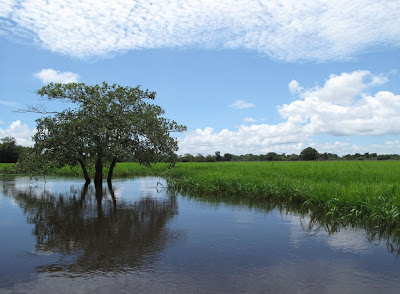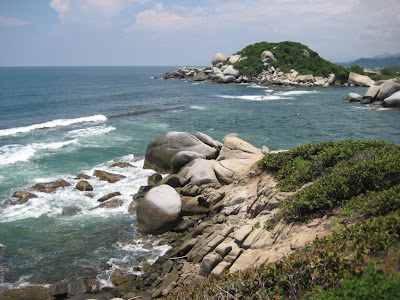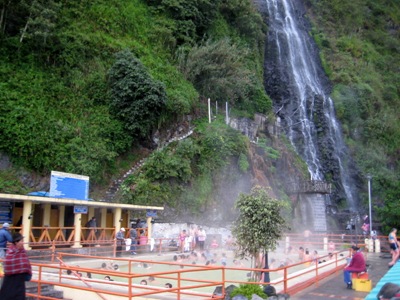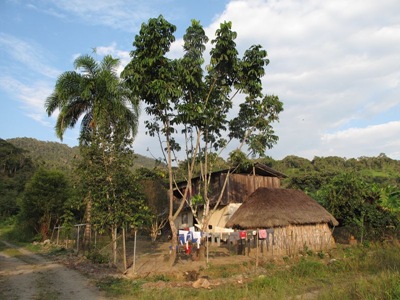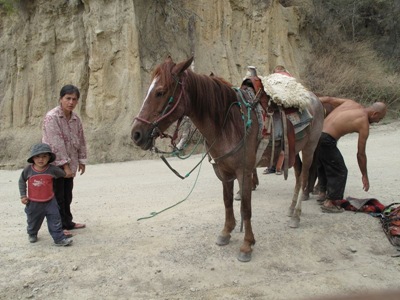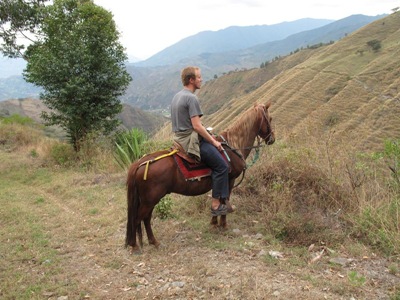Lima, 5 a.m., in the bus to Miraflores district
El Fredovito in charge of city traffic
German tourist, whom the expeditioners helped out from trouble
Upcoming 4 days were spent in towns and villages situated along the west Peruvian coastline. The first stop was in Paracas (after skipping Chilca, famous for its mud baths, due to inconvenient bus connections). Paracas, small village surrounded by coastal dessert, is heavilly visited because of two main natural attractions - Islas Ballestas (aka "Poor-men Gallapagos", amazing island rock formations populated by hundreds of thousands (!) of birds of various species, and some water-based mammals, too, e.g. penguins, pelicans, sea lions and dolphins) and Reserva Nacional de Paracas (vast desert area with exceptional landscape phenomenas) - both providing the expeditioners with remarkable natural views.
Approaching Islas Ballestas, attractive tourist destination
Impressive, neverending chains of birds on the skies, trying to squeeze on already fully occupied islands
Sea lions, penguins and other mammals were easy to spot
Miguel Hudeiro thoroughly exploring beaches around Paracas
Tasty lunch in fishermen's village - ceviche (local equivalent of sushi) as a starter and roasted fresh fish
Proceeding further south, Huacachina village is the center of sand-surfing and sand dunes buggy tours. The adventurers did not spent much time and money on these group attractions and rather took benefit of very pleasant sunny weather and climbed up the highest sand dune in the area to enjoy unusual outlook on close-by town Ica - where the crew broadened their knowledge of Peruvian history in the regional museum.
Just climbed up - after almost an hour struggle with hot sand
Huacachina in the front, Ica in the back, sand dunes all around
Miguel Hudeiro and Don Madonarra chasing each other
Nazca is a world-famous center of influential Pre-Columbian (ca. before 1492) Nazca culture. Flights over the Nazca lines spread across 500 km2 of desert plains around the city are the main target for all tourists hitting Peru. However, after receiving rather reserved impressions of other fellow travellers, the expeditioners decided to make it a light version. One afternoon was eventually enough to observe at least three figures (lizard, tree and frog) visible from the outlook point outside town.
One of many Nazca lines figures (a tree)
Having still some spare time before boarding a night bus to Cuzco, the crew took a cab to admire nearby Cerro Blanco, the highest known sand dune in the world (height of 2.078 m).
Approaching Cerro Blanco, the world's highest sand dune
17-hour bus ride to Cuzco with reportedly one of the most reputable coach operators in Peru turned out to be truly dismal experience - outrageously overpriced, considerably delayed and poorly customer oriented Cruz del Sur is a company not to be recommended further on. The city of Cuzco made it up for them, though - once being the center of the Inca empire, Cuzco is nowadays rightly considered an archeological capital of the entire continent. Late afternoon and night sightseeing allowed the travelers to explore the most beautiful parts of the city, and get a decent sleep before setting off to Machu Picchu.
Plaza de Armas in Cuzco
(the main square in every Peruvian city holds this name)
(the main square in every Peruvian city holds this name)
Local women in traditional dresses posing with baby sheep
May the Maya be with you! :)

















